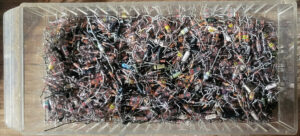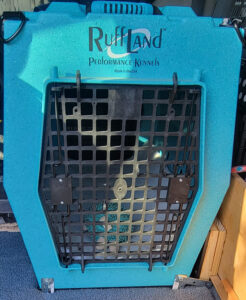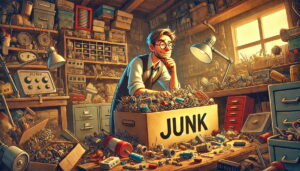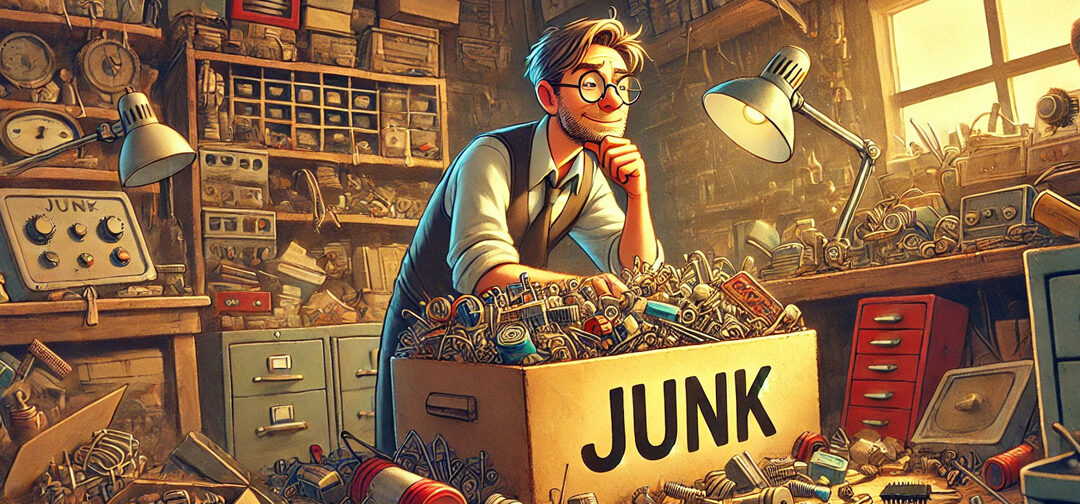Just about every electrical or mechanical engineer I know has some kind of junk box—a treasure trove of parts accumulated over the years, all saved with the hope they might come in handy someday.

I still have my salvaged resistors
My own junk box started at a very early age. Too young to work a part-time job, my chances of obtaining electronic components were slim. But my father stepped in, canvassing the neighborhood for discarded TVs and stereos, which he’d haul home. Sometimes, I fixed them with parts I’d already managed to collect. More often, I’d strip them down, filling my box bit by bit with resistors, capacitors, and vacuum tubes (yes, it was that long ago). I felt a little thrill each time I added a new piece to my stash.
Technology has since changed, and my income has increased, so these days there’s not much worth salvaging, aside from the odd LED or switch. But I still save nuts, screws, and bolts—having these collection has saved me more than once.

Venn
When my wife’s car reached 172,000 miles, she decided it was time for a new canine transporter. Naturally, it fell to me to transfer the crates from her old vehicle to the new one. We’d carefully selected a new car to make the transition as seamless as possible, but it was a few inches shorter, which meant I’d need a new mounting plan. My junk box came to the rescue, yielding two eyebolts, and after a lot of searching, four matching nuts. That moment, pulling exactly what I needed from a trove of parts, is what makes a junk box essential.
When Venn joined our family, my wife added a third crate in the center, where there were few options for securing it without overhauling the setup. She asked if I could provide two more eyebolts to bungee Venn’s crate in place. I had plenty of eyebolts, but I remembered how hard I’d worked to find those four nuts. Now she wanted two more eyebolts?
Thankfully, Amazon had nuts available for next-morning delivery. After thinking about it, I added a set of lock nuts just for good measure.

Venn’s Safety Travel Crate
The more I thought about it, the less happy I was to have Venn’s crate secured with bungee cords. Here’s where a well-stocked junk box truly shines. I rummaged through my collection, hoping for inspiration. Nothing seemed right—until I spotted a pair of large support arms intended for a floating countertop. Maybe, just maybe, if I attached them to the platform and used some brackets… After a quick trip to Lowe’s, Venn’s crate was firmly and safely mounted, yet easily removable. It wasn’t just the parts; it was the inspiration my junk box sparked, and that made me smile.
Being retired has eliminated a lot of stress. When I was an engineering manager, I was often involved in discussions between purchasing, accounting, and engineering, especially when an engineer was trying to build up a good stock of immediately available parts.
Here’s a familiar scene:
**Purchasing**: “You only need twenty resistors; why did you order one hundred?”
**Engineer**: “Because it’s cheaper to buy one hundred than twenty.”
**Accounting**: “How do you intend to dispose of the other eighty?”
**Engineer**: “I’m going to add them to the lab supplies for future projects.”
Yes, I’ve been part of that conversation.
Bear in mind, the cost for one hundred resistors is trivial, but government-mandated accounting practices make this difficult. Were they purchased for a government contract and the surplus used on a commercial contract?

It can get away from you
If these parts are at risk of getting out on the production line, you have a whole new set of concerns. Are these parts stored in a controlled environment? How can you ensure they were purchased to the contract requirements? How do you convince an auditor this isn’t normal practice to avoid showing actual costs?
As they made it more difficult to order parts (more signatures, more justification), Accounting was astonished to discover engineers using their own money to buy the parts they needed: faster, cheaper, no red tape. Sure, it throws off inventory, lacks quality assurance, and the engineer never gets reimbursed. But when you’re working to complete a design, solutions come before paperwork.
Take what you will from this story, but keep these points in mind:
– A good junk box can inspire solutions and save the day when you’re in a pinch.
– Junk boxes grow fast; they require a little restraint.
– Moving from personal to commercial, while excess components from production can be added to a lab’s junk box, components from the lab should never, ever, be used for production.
– Engineers are problem solvers; throw roadblocks in their way, and the solution may not be what you expected.
As for me? I’m grateful I had the nuts, bolts, and brackets when I needed them. I’m very happy that it inspired me to a better solution for Venn’s crate than bungee cords. However, most of my work shed is dedicated to storing parts that may come in handy someday. It is possible to take this concept a little too far. Just ask my wife.

My wife’s vision of the perfect vehicle
© 2024, Byron Seastrunk. All rights reserved.










